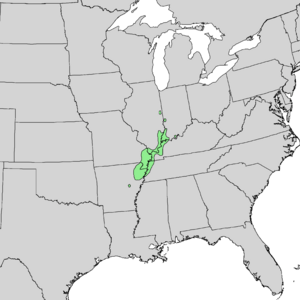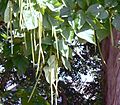Northern catalpa facts for kids
Quick facts for kids Northern catalpa |
|
|---|---|
 |
|
| Scientific classification | |
| Genus: |
Catalpa
|
| Species: |
speciosa
|
 |
|
| Natural range of Catalpa speciosa | |
The Northern Catalpa (scientific name: Catalpa speciosa) is a beautiful tree from the midwestern United States. People also call it the hardy catalpa, western catalpa, or cigar tree. Its scientific name, speciosa, means "showy" because of its lovely flowers.
Contents
What the Northern Catalpa Looks Like
The Northern Catalpa is a medium-sized tree. It can grow to be 15 to 30 meters (about 50 to 100 feet) tall. It can also spread out about 12 meters (40 feet) wide. Its trunk can be up to 1 meter (3 feet) across. The bark is brown to gray and becomes rough with hard plates as the tree gets older.
Leaves, Flowers, and Fruit
The leaves of the Northern Catalpa fall off each year, so it's a deciduous tree. They grow opposite each other on the branch, or sometimes in groups of three. The leaves are large and shaped like a heart. They are 20 to 30 cm (8 to 12 inches) long and 15 to 20 cm (6 to 8 inches) wide. They have a pointed tip and feel soft and hairy underneath.
Interestingly, catalpa trees are often the last trees to grow their leaves in the spring. In autumn, their leaves usually don't change color much before falling. They might turn a light yellow-brown or just drop suddenly after the first big freeze.
The flowers are trumpet-shaped and about 3 to 6 cm (1 to 2.5 inches) wide. They are white with yellow stripes and purple spots inside. These pretty flowers grow in large clusters of 10 to 30.
After the flowers, the tree grows long, thin seed pods. These pods look a bit like legumes or cigars, which is why it's sometimes called the "cigar tree." They are 20 to 40 cm (8 to 16 inches) long and about 1 cm (0.4 inches) thick. The pods often stay on the tree all winter, sometimes looking like brown icicles. Inside, each pod has many flat, light brown seeds with two papery wings.
The Northern Catalpa is very similar to the Southern Catalpa. You can tell them apart by their flowers and seed pods. The Northern Catalpa has fewer, but larger, flowers in its clusters. Its seed pods are also a little wider.
Where Northern Catalpas Grow
Scientists first thought the Northern Catalpa only grew in a small part of the midwestern United States. This was near where the Mississippi River and Ohio River meet.
However, in 1976, something interesting was found. At an old archaeological site on an island in the Ohio River, people found evidence of Northern Catalpa trees from the 1500s to 1700s. This suggests that the tree might have grown in more places before Europeans settled there. Today, the Northern Catalpa grows widely across the eastern Rocky Mountains. This makes it harder to know exactly where it originally came from.
How People Use Northern Catalpas
The Northern Catalpa is often planted as an ornamental tree. This means people plant it because it looks nice in gardens and parks. It grows best in moist soil with a high pH and lots of sunlight. But it can grow almost anywhere in North America. In the UK, it even won a special award for garden plants called the Royal Horticultural Society’s Award of Garden Merit.
Wood and Its Uses
The wood of the Northern Catalpa is soft and light, similar to white pine. It weighs only about 26 pounds per cubic foot when dry. A great thing about this wood is that it doesn't rot easily. Because of this, people used it for fence posts a long time ago. They also tried to use it for railroad ties, but that didn't work as well.
Today, the wood is used for furniture, inside decorations, and cabinets. It has a beautiful grain. Catalpa wood also has one of the lowest shrinkage and expansion rates of any U.S. hardwood. This means it doesn't change size much with changes in moisture. This makes it great for carving and building boats. Even though it's a good wood, it's often not used enough because the trees can grow a bit crooked.
Farmers in Ohio have grown Northern Catalpas for over 200 years. They planted these fast-growing trees to get lots of wood for fence posts. Now, you can find them growing wild in cities and the countryside there.
Things to Consider in Cities
While Northern Catalpas are beautiful, they can cause a few small problems in cities:
- The long seed pods and fuzzy seeds fall from the tree from winter through spring. This can create a lot of cleanup work.
- The tree can grow very large. Sometimes it gets too big for the space it's in. It might crowd out other plants or cast too much shade on them.
- Its wood can be brittle. This means its branches can sometimes break during strong winds or ice storms.
Northern Catalpa and Fishing
Fishing fans often look for Northern Catalpa trees. Not for the tree itself, but for a special caterpillar that lives on it! The catalpa moth caterpillar, called Ceratomia catalpae, is one of the best live baits for fishing. Some people even plant these trees just to get the caterpillars for bait. This is why the tree is sometimes called the "worm tree" or "bait tree."
Tree Health
Northern Catalpa trees are usually quite strong. They can get some diseases or pests, but most of these are minor. They don't usually cause serious harm to the tree. The main exception is the Ceratomia catalpae caterpillar. These caterpillars can sometimes eat almost all the leaves off the tree. However, even when this happens, the tree usually recovers and isn't hurt too badly.
Gallery
-
Tree in flower in Winnemucca, Nevada
See also
 In Spanish: Catalpa occidental para niños
In Spanish: Catalpa occidental para niños









